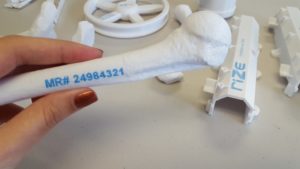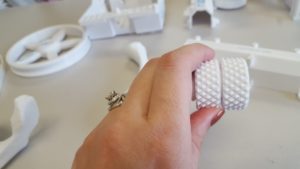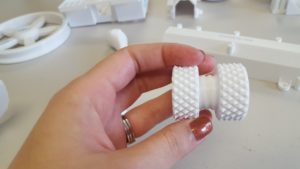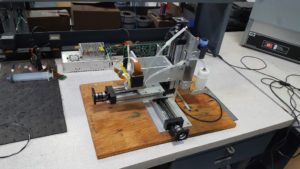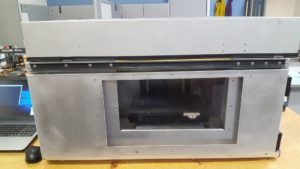
Rize President and Founder Eugene Giller and Vice President of Marketing Julie Reece in front of the company’s awards
3D printing is taking off in Boston, and Rize Inc. is among the companies leading the charge. Recently, I had the opportunity to sit down with company President and Founder Eugene Giller and VP of Marketing Julie Reece at the company’s Woburn, Massachusetts headquarters. Rize is located in a business park that houses three other additive manufacturing companies, underscoring Giller’s point that the area is a true center of technology due to the many big educational centers nearby as well as the local heritage of 3D printing.
“Companies like Objet and Z Corp were in this area,” Giller noted as we chatted. “When those were acquired, the folks left stayed in the area.”
This leftover faction of experienced professionals is a great resource to companies like Rize, which was among those quick to take advantage of the skilled talent pool. Giller, himself coming from a Z Corp background, founded Rize and has been watching it grow in the conducive environment of tech-heavy Boston. The company emerged last summer from stealth with its patented Augmented Polymer Deposition (APD) technology, aiming to strengthen 3D printed parts and minimize post-processing requirements and allowing for the color inkjet printing of detailed text and images directly into parts. For a company devoted to strength in additive manufacturing, strength in business is also clearly an area well in focus.
The Rize One 3D printer began commercial shipments in June of this year and has since been finding its footing in the market, fine-tuning its offerings and message as Rize ramps up. APD technology has been finding traction in particular in demanding applications including aerospace and defense, pharmaceutical, and medical devices, Giller explained. Key to these advances have been the strength of parts possible as well as FDA approval for certain kinds of contact, along with the ability to sterilize the material. We discussed several new Rize customers, and should be hearing more in the near future regarding new case studies where the unique technology from Rize has been beneficial in practical application.
A particular “sweet spot” for Rize’s 3D printing technology has proven to be in replacement and custom tooling, as well as fixtures and jigs. The ability to create functional parts has additionally drawn interest from the military, as the inclusion of colored ink that can indicate part number, designer, creator, and other practical information directly in a part fits well with the Army’s required audit trail that requires such information to be reported. In-field 3D printing of replacement parts, such as trigger replacements, is a burgeoning opportunity for additive manufacturing in the armed services.
Since the Rize One entered the marketplace with commercial shipments, the company behind it has been keeping in close contact with customers. Giller noted that the company has been responding to feedback in order to optimize user experience.
“As soon as we started delivering products to customers, we realized where we needed to focus, such as education,” he told me.
“We have also started working on new materials; our first was a generic polycarbonate, and we have now had requests for softer options… The goal is to provide a range of thermoplastics. For software, we have been focusing on the user interface, and making this cleaner. We are improving file fix features and right now can deal with about 95% of files.”
In keeping with known applications, the company is also looking to add features for functional parts that will be designed to show wear and tear. The colored ink capabilities allow for the inclusion of an image in a part that will show more as outer layers wear away through use, creating an easy visual reference for users to know at a glance when it is time to replace a part and print a new one.
During my time on-site with Rize, I enjoyed a look at the operations centers, including the small materials development lab where new formulations are being explored. All materials are developed in-house, while the machines themselves are manufactured in Vermont; Rize performs quality checks on all equipment with in-house inspection.
I also saw the progression of hardware in place, from the first iteration of the idea that became the Rize One to a beta printer and production unit. From beta to production, among the biggest updates were additional safety features and an improved look — these machines are able to operate on the desktop in offices, and attention was paid to the detail to ensure the hardware looked like it would fit in in an office environment. The production 3D printers are also CE compliant as safety compliance was a focus.
- The earliest Rize 3D printer
- A boxy beta unit
- Production Rize One 3D printer
The company has been expanding its dealer network across the US as sales increase. New customers have already been placing repeat orders for consumables as installed units are seeing significant use. With early success in the US market, Rize has its eye next on the UK and Europe; kicking off these efforts will be the Rize One’s first functional appearance in the UK in a few weeks at TCT Show. The European debut is set for late 2017 and early 2018, and a strategy is in place to expand availability in 2019 to Asia as Rize sets its sights on global reach.
The time at the heart of Rize’s operations showed me a company with a keen understanding of current market conditions and a smart maneuvering into position. I look forward to upcoming weeks and months when we can share more of the news to come from Rize — this cool 3D printing company is one to keep an eye on, as its technology and offerings show great promise.
[All photos: Sarah Goehrke]
Subscribe to Our Email Newsletter
Stay up-to-date on all the latest news from the 3D printing industry and receive information and offers from third party vendors.
You May Also Like
New Report: Semiconductor Industry to See $1.4B in 3D Printing Revenues by 2032
“The semiconductor sector has become the most strategically significant area of global industry.” Truer words are hard to come by when it comes to the modern world, and they are...
Will Photonic-Crystal Lasers Revolutionize 3D Printing?
Powder bed fusion (PBF) for metals and polymers predominantly utilizes lasers as the primary heat source. Some directed energy deposition (DED) technologies also employ lasers, while various vat polymerization methods...
3D Printing Unpeeled: Orbex Investment, IndoMIM and HP, Ultrasonic Waves
INDO-MIM has bought three HP Metal Jet S100 printers, operating two in India and one in Texas. This is a win for HP because the company has deep experience in...
3D Printing Webinar and Event Roundup: April 21, 2024
It’s another busy week of webinars and events, starting with Hannover Messe in Germany and continuing with Metalcasting Congress, Chinaplas, TechBlick’s Innovation Festival, and more. Stratasys continues its advanced training...




